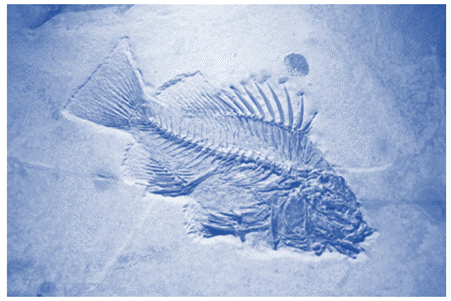
Concept explainers
Challenge Yourself
Living plants and animals all contain the chemical element carbon. A certain percentage of that carbon is radioactive, and scientists believe that the parentage has remained constant for thousands of years. Radioactive carbon decays, so that when an animal dies, a tiny bit of the
radioactive carbon is lost each year. It is known that the amount of radioactive carbon that remains in a fossil at the end of a year is approximately 0.99988 of the amount that was present at the beginning. Thus, the following dynamical system describes radioactive carbon
decay in a fossil:
This system behaves exactly like the compound interest situation (except the amount or radioactive carbon is decreasing), so it is easy to see that after k years, the amount of radioactive carbon in the fossil will be
radioactive carbon at time 0 will be 1; that is,

Carbon dating. A leaf of a fossilized plant is found that contains 60% of the original radioactive carbon that was present. To the nearest 100 years, how old is the plant?
Want to see the full answer?
Check out a sample textbook solution
Chapter 7 Solutions
Mathematics All Around-Workbook
- The graph of f(x) is given in the figure below. draw tangent lines to the graph at x=-3,x=-2,x=1,and x=4. estimate f'(-3),f'(-2),f'(1),and f'(4). Round your answers to one decimal place.arrow_forwardConsider the functions f(x)=4x-1 and g(x)=sq root of -x+7. Determine 1. f o g(x) 2. Give the domain of f o g(x) 3. g o f (x) 4. Give the domain of g o f(x)arrow_forward12. lim h→0 √5x+5h -√5x h where x>0 is constaarrow_forward
- If f(x)=x2+4, g(x)=x-6, h(x)=sq root of x, then (f o g o h)(x)=arrow_forwardIf f(x)=x2+4, g(x)=x-6, h(x)=sq root of x, then (f o g o h)(x)=arrow_forwardYou are given a plane Π in R3 defined by two vectors, p1 and p2, and a subspace W in R3 spanned by twovectors, w1 and w2. Your task is to project the plane Π onto the subspace W.First, answer the question of what the projection matrix is that projects onto the subspace W and how toapply it to find the desired projection. Second, approach the task in a different way by using the Gram-Schmidtmethod to find an orthonormal basis for subspace W, before then using the resulting basis vectors for theprojection. Last, compare the results obtained from both methodsarrow_forward
 Glencoe Algebra 1, Student Edition, 9780079039897...AlgebraISBN:9780079039897Author:CarterPublisher:McGraw Hill
Glencoe Algebra 1, Student Edition, 9780079039897...AlgebraISBN:9780079039897Author:CarterPublisher:McGraw Hill
 College Algebra (MindTap Course List)AlgebraISBN:9781305652231Author:R. David Gustafson, Jeff HughesPublisher:Cengage Learning
College Algebra (MindTap Course List)AlgebraISBN:9781305652231Author:R. David Gustafson, Jeff HughesPublisher:Cengage Learning Trigonometry (MindTap Course List)TrigonometryISBN:9781337278461Author:Ron LarsonPublisher:Cengage Learning
Trigonometry (MindTap Course List)TrigonometryISBN:9781337278461Author:Ron LarsonPublisher:Cengage Learning
 Algebra for College StudentsAlgebraISBN:9781285195780Author:Jerome E. Kaufmann, Karen L. SchwittersPublisher:Cengage Learning
Algebra for College StudentsAlgebraISBN:9781285195780Author:Jerome E. Kaufmann, Karen L. SchwittersPublisher:Cengage Learning





